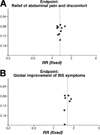Effects of 5-hydroxytryptamine (serotonin) type 3 antagonists on symptom relief and constipation in nonconstipated irritable bowel syndrome: a systematic review and meta-analysis of randomized controlled trials
- PMID: 18242143
- PMCID: PMC2587294
- DOI: 10.1016/j.cgh.2007.12.015
Effects of 5-hydroxytryptamine (serotonin) type 3 antagonists on symptom relief and constipation in nonconstipated irritable bowel syndrome: a systematic review and meta-analysis of randomized controlled trials
Abstract
Background & aims: We performed a systematic review and meta-analyses to estimate treatment efficacy and constipation rate of 5-hydroxytryptamine (serotonin) (5-HT(3)) antagonists in patients with nonconstipated (NC) or diarrhea-predominant (D)-irritable bowel syndrome (IBS).
Methods: Two reviewers independently searched MEDLINE, EMBASE, and Web of Science (January 1, 1966 to December 15, 2006) for randomized controlled trials of 5-HT(3) antagonists in IBS reporting clinical end points of the IBS symptom complex and safety parameters. Study characteristics, markers of methodologic quality, and outcomes for the intention-to-treat population for each randomized controlled trial were extracted independently.
Results: We found 14 eligible randomized controlled trials of alosetron (n = 3024) or cilansetron (n = 1116) versus placebo (n = 3043) or mebeverine (n = 304). Random-effects meta-analyses found 5-HT(3) antagonists more effective than the comparators in achieving global improvement in IBS symptoms (pooled relative risk, 1.60; 95% confidence interval [CI], 1.49-1.72; I(2) = 0%) and relief of abdominal pain and discomfort (pooled relative risk, 1.30; 95% CI, 1.22-1.39; I(2) = 22%). Benefit was apparent for both agents, in patients of either sex. These agents were more likely to cause constipation (pooled relative risk, 4.28; 95% CI, 3.28-5.60, I(2) = 65%); there was less constipation with 5-HT(3) antagonists in D-IBS patients than in mixed populations (NC-IBS and D-IBS; relative risk ratio, 0.65; 95% CI, 0.41-0.99). Nine patients (0.2%) using 5-HT(3) antagonists had possible ischemic colitis versus none in control groups.
Conclusions: 5-HT(3) antagonists significantly improve symptoms of NC-IBS or D-IBS in men and women. There is an increased risk of constipation with 5-HT(3) antagonists, although the risk is lower in those with D-IBS.
Figures





References
-
- Drossman DA, Sandler RS, McKee DC, Lovitz AJ. Bowel patterns among subjects not seeking health care. Use of a questionnaire to identify a population with bowel dysfunction. Gastroenterology. 1982;83:529–534. - PubMed
-
- Talley NJ, Zinsmeister AR, Van Dyke C, Melton LJ., 3rd Epidemiology of colonic symptoms and the irritable bowel syndrome. Gastroenterology. 1991;101:927–934. - PubMed
-
- Drossman DA, Li Z, Andruzzi E, Temple RD, Talley NJ, Thompson WG, Whitehead WE, Janssens J, Funch-Jensen P, Corazziari E, et al. U.S. householder survey of functional gastrointestinal disorders. Prevalence, sociodemography, and health impact. Dig Dis Sci. 1993;38:1569–1580. - PubMed
Publication types
MeSH terms
Substances
Grants and funding
LinkOut - more resources
Full Text Sources

